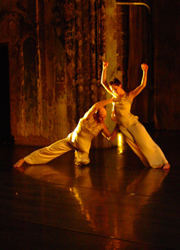Coming-Out Party: Arena Dances at Ten
Lightsey Darst saw "Ten," the tenth-anniversary performance of Arena Dances, choreographed by Mathew Janczewski at the Southern Theater. It runs through October 22. She posits that this choreographer needs the "freakishly gifted" to do his best work.

In the arts, a ten-year anniversary is an achievement—particularly in dance, where costs are high, pay is low, and the work is physically and logistically difficult. Anyone crossing the ten-year finish line deserves not only champagne and cake, as Mathew Janczewski had at Friday night’s performance of Ten, but support and long applause. A ten-year anniversary, however, is not merely a moment of celebration; it is also a natural point for assessment.
So. Mathew Janczewski can make big steps and he can use the big steps others have made: his dances soar, tumble, float, writhe. He knows how to put bodies together, how to create shapes that twist and decay before the viewer has quite figured them out, leaving echoes of connection in the air. He knows how to use that air too: how to launch dancers through it, how to carve and rend and mend it, how to enliven it. He has a knack for endings, composing them as question marks or ellipses rather than periods or exclamation marks, often throwing in a twist just before darkness falls. He smoothly integrates music, light, and other elements into his larger design. In other words, his choreographic technique is strong: he can do the things that choreographers need to be able to do. This is admirable but not particularly interesting.
What’s interesting is what Janczewski does that others don’t. It’s not the splashy space-eating movement of his work (its most prominent feature) that interests me but the origin of this movement in dramatic physicality. For Janczewski, the body has moods, a startling variety of them, and each is a legitimate starting place. You see this in the subtlety and range of his partnering. In 2003’s Open Eyes, Janczewski and Amy Behm-Thomson lean against each other at sharp, precarious angles, then stand apart, in a relation that might be brother-sister but might also be the wearing of element against element.
In the evening’s standout, Judged House (1996), Christine McGinnis and Tamara Ober support each other, then move apart in icy, dramatically lit separations, charge into each other’s arms in risky lifts, and then shift between wrestling and moving in unison. Their tense, complex relationship changes through the piece—they are sisters, Jacob and the angel, warring countries, divided ideas, haunted survivors. Even in the conventional male-female marriage partnering of “Prairie,” Janczewski manages emotional complexity, the women reaching a hesitant hand forward as if to touch a window while the men lower them slowly to the floor as if ploughing, digging, with the women’s bodies: love as platform and love as labor. Janczewski isn’t creating steps that convey emotions or ideas; he’s working from the inside out, from the undivided body-heart-mind.
His sensitivity to the origins of action makes it no surprise that Janczewski also shows great sensitivity to his individual dancers. Behm-Thomson’s angelic purity and focus, Stephen Scroeder’s animal magnetism, Galen Treuer’s youthful energy, Susie Bracken’s sensual grace, Tamara Ober and Christine McGinnis’s tense strength, and his own superhuman smoothness—Janczewski sees and revels in all these various talents, making for each dancer a haloed moment. This unusual ability to alter his style to suit the dancer gets Janczewski in some trouble when he’s not dealing with virtuosos, though. In group works and in solo moments for less astonishing dancers, Janczewski’s choreography sometimes sinks to blandness, a stir of limbs, a flurry of moves we’ve seen before. It’s not that there are any slouches in this group: all the dancers in Ten can do the steps, which is quite an achievement. But Janczewski needs the freakishly gifted—the dancers who can pause midair, who can think and feel while flying—to do his best work.
And this brings up a natural question for a ten-year anniversary: what next? So many arts anniversaries sigh with exhaustion: here we are, we’ve been doing this for a while, and, hard as it is, we’re still at it. But Janczewski’s ten-year anniversary feels like a coming-out party. Over the past few years his work has become more itself and it turns out that Arena Dances has a stunning self to become: physically brilliant yet emotionally intimate, dramatic, widely varied, witty and heartfelt. It’s tempting to compare Janczewski to nationally prominent choreographers because of his technical proficiency and his appeal to both novice audiences and dance insiders. That national prominence is a workable goal for him (for proof, note that the Walker has commissioned a piece from him for next year). But how will he get there from here?
Arena Dances has, for ten years, been a company in that Janczewski has created at least one performance a year and always used the same company name. While he’s had some steady dancers (notably Behm-Thomson), Janczewski does not have a roster, a paid company. This would be an incredibly expensive step to take. But Janczewski needs specific and individual dancers to move his work forward, to move further into what he alone can do. What if, after his upcoming Walker commission, Janczewski become a choreographer in residence at, let’s say, Zenon, which is the home of so many of his standout dancers?
Janczewski is in a crucial moment for his work. Will the next ten years take him to the next level? Let’s wait—or not wait, but help—and see. In the meantime, though, there’s Ten to enjoy.